|
FAQs about the Tang
Identification
Related Articles: The
Surgeonfish family, Acanthurus, Ctenochaetus, Naso, Paracanthurus, Zebrasoma , Prionurus, Surgeonfishes of Hawai'i, Surgeonfishes for Reef
Systems,
Related FAQs: By Genus/Species: Acanthurus ID, Powder Blue Tang Identification, Ctenochaetus Identification, Kole Identification, Naso ID, Lipstick Tang
Identification, PYTB Tang
ID, Zebrasoma
Identification, Yellow Tang
Identification, Purple Tang
Identification, & Tangs in General, Selection, Tang
Behavior, Compatibility, Systems, Feeding, Disease,
Some tangs are much more easily identified to
species than others...
|
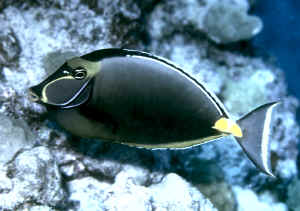
|
Surgeonfishes: Tangs for Marine Aquariums
Diversity, Selection & Care
New eBook on Amazon: Available here
New Print Book on Create Space: Available
here
by Robert (Bob) Fenner |
 |
|
Tang id 3/22/20
Hey guys how are we doing today just got a very interesting one in from our
diver in Hawaii this was imported in with the black tangs and Scopas hybrids
<... this fish came from, was caught in Hawai'i? Lo dudo>
Did not know if you had any extra input on what type of hybrid this is but
it does not match to the other scopas hybrid have this one as you can see
has banding going from the top to bottom of the body and has a very nice
vivid electric blue ring around the outside of the body could this just be
that it’s a half inch smaller?
<Yeah, have seen quite a bit re this apparent hybrid on the Net the last
week or so. The principal story is that the purple tangs they're culturing
at Bali Aquarich are housed, mixed with yellows and scopas; and a few
striped ones with purple and yellow are resultant from crosses between
Zebrasoma xanthurum and Z. flavescens. Time/growth, poss. genetic testing
may tell. BobF>
|
.jpeg) |
|
Help with Tang ID 7/24/13
Hello crew,
A couple of years ago, I purchased the tang in the attached picture.
It was sold as a Lavender tang. Today, I noticed the white band on
its tail.
I don't think it's a Lavender tang. It has blue lips, blue stripes
on its face, body, and fins, and yellow around its eyes. I'm
worried that it is actually a Ring Tail tang. What do you think?
My tank is 150 gallons.
<Mmm, this is almost assuredly an Acanthurus nigroris... Cuvier's
Bluelined Surgeon... by other name/s. Bob Fenner>
Thanks,
Laurie
|
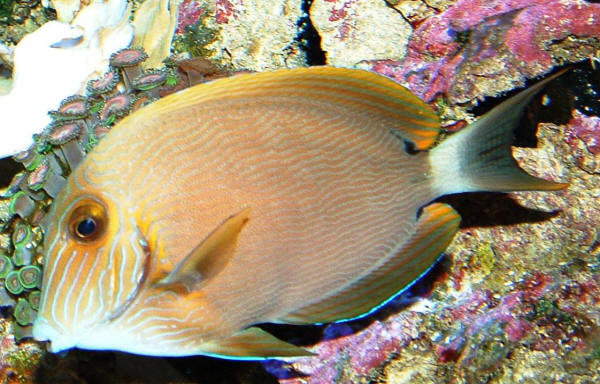 |
Re: Help with Tang ID
7/25/13
Thank you Bob. Just before I read your reply, I found a picture and
description of the Bluelined Surgeon, and wondered if that was my fish.
After a little further searching, I found its home aquarium specifications -
max adult size of 10"; 75 gallons minimum tank;
<I'd state twice this>
rare in the aquarium trade. I am lucky to have one! And It
should be just fine in my tank. It's been very healthy and hardy, so far.
Thank you, once again, for your help.
Laurie
<And you for this follow up. Cheers, BobF> |
|
Tang ID 7/29/10
Hi,
I need an ID on this Ctenochaetus?
<Mmm, I don't this fish is of the comb-tooth genus... It
may be Acanthurus nigroris>
Tang. Its around 2 inches in size and has no spots on its face.
The pics attached are with and without flash.
Regards
Beta Mahatvaraj
<Any idea where (geographically) this fish was collected? Bob
Fenner>
|
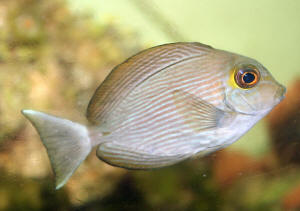 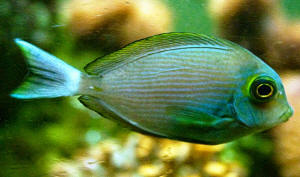 |
Re: Tang ID
Hi Bob,
Do any of the Acanthurus have yellow around the eye as juveniles?
This one does.
<At least five of the thirty two species I'm aware of
do>
These were collected off the South Western coast of India.
<See Fishbase.org, WWM re. BobF>
Regards
Beta
http://fishbase.org/Summary/speciesSummary.php?ID=4738&genusname=Acanthurus&speciesname=nigroris&lang=English
http://wetwebmedia.com/AcanthurusBad.htm
Re: Tang ID 8/2/10
Thanks Bob. I will look it up on Fishbase.
<Okay... there are not many species of fishes that are
well-documented pic-wise as juveniles on up... BobF>
Re: Tang ID 8/9/10
Hi Bob,
I sent the pics to a scientist at the Zoological Survey of India
and she thinks its likely to be *Acanthurus xanthopterus*.
Regards
Beta
<Possibly. Thank you for this follow-up. BobF>
|
|
Tang ID And Writer May Have Been Taken
For A Ride 1/16/10
Hi
<Hello Darren>
I am looking for help identifying a tang I bought as a Gold Rim
Tang.
Looked up and doesn't really match.
Hope you can help
<I sure can Darren, what you have is a Tomini Tang. You may
have been taken to the cleaners depending on what you paid for
it, as a 2-3" Gold Rim Tang (Acanthurus nigricans) generally
etails for about 70 bucks, while the same 2-3" size in a
Tomini Tang (Ctenochaetus tominiensis) runs around 50 bucks
keeping in mind that pricing will vary among etailers.
The Tomini Tang is relatively hardy and a little more disease
resistant than the Gold Rim Tang, at least in my
opinion/experience.
I have had my Tomini now for close to three years now and it
really is a beautiful fish who gladly accepts my offerings of New
Life Spectrum Pellet Food, a highly nutritious formula. James
(Salty Dog)>
Darren Coughlan
|
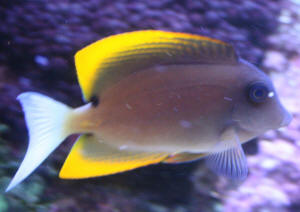 |
Re Tang ID And Writer May Have Been
Taken For A Ride 1/16/10
Thanks,
<You're welcome.>
paid about 25 pounds for when it was a little smaller.
<Mmm, 40 bucks isn't too bad a price considering where you
are located.>
Very lively, inquisitive and active.
Happy to know and look forward to looking after it
Quick response genuinely appreciated knowing how many questions you
must get.
Keep up the great work.
<Thank you, we will try our best.>
Thanks again,
<You're welcome. James (Salty Dog)>
Darren Coughlan |
|
Tang ID 7/7/09
Hello,
<Hi Eric>
I would like some help identifying this Tang/Surgeonfish
(attached). It was received with the simple name Purple Lineatus
Tang, but no scientific name.
I have attached two images. It's nearly impossible to take a
picture of him.
<Like my wife. There is an Acanthurus Lineatus (Clown
Surgeonfish), but that is not what you have. Your tang appears to
be from the genus Ctenochaetus (Bristle-Tooth Tang), likely the
Striped Bristle-tooth Tang. Your input,
Bob?
<<At least the right genus. RMF>>
Thanks,
<You're welcome. James (Salty Dog)>
Eric Bergevin
|
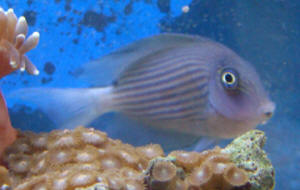 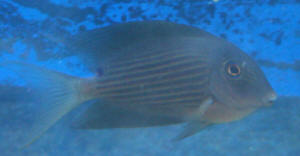 |
|
Tang ID - 09/12/08 Thanks to
everyone there for providing such a great resource for all of us
in this hobby. I am hoping you can help me identify this tang.
<Mmm, pretty sure this is a Ctenochaetus flavicauda> Sorry
for the photo quality, it was taken at my LFS on my camera phone.
I'm trying to research this tang before I possibly purchase
it and am not exactly sure what it is. I have looked at many
photos, including ones you have here on this site and am still
not quite sure I'm finding one that seems to match it with
the horizontal lines and white on the tail, maybe due to it's
level of maturity vs. the level of maturity of the fish in the
photos I'm looking at. <Yes... is young. Looks like a
healthy specimen... and this is a "tough" genus>
This photo is somewhat overexposed, the tang is actually a fair
amount darker. The fish in question is approximately 3" to
4" long. The store has it listed as a black tang and the
only other info is that it is possibly from Sri Lanka. Thanks for
any help you can provide and for the immeasurable help you
already have! Joan <Welcome! Bob Fenner>
|
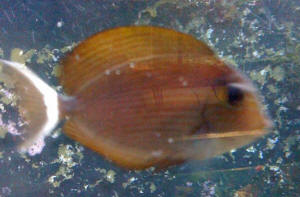 |
|
Acanthurid ID mystery
8/21/08Hello WWM Crew, This is my first time inquiring about
anything before (on wwm). I generally try to answer my own
questions by searching the web endlessly and I cannot for the
life of me identify my latest tank purchase. For a long time I
wanted a "show piece" fish and I had my eye on a
Majestic Angel. After long debate about it, I decided against due
to their coral nipping habits. Well during my last "fish
run" I saw a tang that I had never seen before and thought
that would be a beautiful center piece for my tank. I bought it
from a very well know store in the area so I didn't think
twice about it when he told me it was a "White Face
Tang." After searching for other WFT I realized I had
purchased something else. I believe it to be a member of the
Acanthurus family but am not positive. <Does appear to be of
this genus...> The fish has a yellow tail, similar to the
shape of an Achilles Tang. The body is a dark grey color. The
side fins (fin name escapes me at the moment) are similar to the
body color except for the fact that they fade from the grey color
to a yellow. The dorsal fin is the same color as the body except
for a thin blue lining around the very tip (bottom fin is the
same as well). There are also white spines that stick out from
the dorsal fin (very small spines). I recently saw a tang on a
website similar to mine referred to as a White Spine Tang. The
fish has since been sold and I can't recover any photos to
reference. <I've looked through my in-print ref.s and
Fishbase.org's "family" pix... and don't see
anything that matches this either...> Its behavior is very
docile. It picks the rocks/gravel endlessly all day and eats
anything else I drop in the tank...except for pellets. Hopefully
these descriptions can help you help me identify this fish.
Thanks for your time! Brian ps - will you let me know by email
when a response has been posted? <Will go up today...
hopefully someone who does know will chime in... Do you have any
idea where this fish originated? From which wholesaler? Bob
Fenner>
|
|
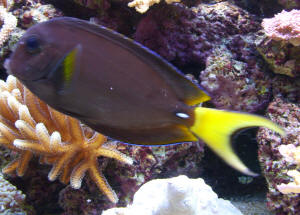
|
Re: Mystery Acanthurus ID 8/21/08 Hello again,
I believe I may have found a name for our mystery fish. I
came across a link to another picture of one and it was
referred to as a Acanthurus Leucocheilus or Pale Lipped
Surgeonfish. Thanks, Brian <Had considered this... I
take it you think the coloration of your specimen is just
this aberrant. Bob Fenner>
Re: 8/22/08 Hi guys, <Brian>
I called the dealer today and he stated they buy their fish
from STC <Mmm, likely SDC, Sea Dwelling Creatures... the
Cohen bro.s... Eric and Scott. Good folks, co.> but he
wasn't sure which region it came from. <Mmm,
sometimes, usually with more "expensive" or rare
specimens, the region of origin is foot noted on
invoices... But, most all folks buy from many locales for
sure> He said he'd ask if they know specifically
where it came from next time he placed an order. I managed
to get a little clearer picture to replace the partially
blurry one. Thanks, Brian <Is a beauty in any case. A
couple of comments, hopefully of use here: There is quite a
bit of regional diversity to color and markings of many
Acanthurids... and there is a possibility that this may be
a cross... even a smaller one that it's an undescribed
species. In recent years, Dr. Randall has revised
Ctenochaetus, adding new.... Bob Fenner>
|
|
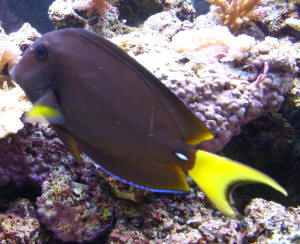
|
|
Tang taxonomy, naming 03/04/2008 Dear WWM
crew, Thanks for your extremely informative and helpful site. I
recently added a tang that has been called a lavender tang, it was sold
from LFS as a palani tang. From the picture on the WWM section dealing
with tangs, it is listed as Acanthurus nigrofuscus. <Yes... this is
likely the most commonly applied name for the Lavender... the Palani is
most often Acanthurus dussumieri> Another site has the same fish
listed as Ctenochaetus Nigrofuscus. <Mmm, there is no such fish... I
think they've got the genus wrong here... the only species name
applied to Acanthurid/oids for nigrofuscus is Acanthurus...> Can you
please help to clarify which is the correct listing? I'm asking
because it is behaving very much like a member of the Ctenochaetus
family. <Mmm, not a family, but a genus...> It is actively
feeding on a lush growth of algae in my 40 gal. holding tank that
contains live rock and cleaner shrimp. I prefer to use this method to
quarantine my fish instead of using copper. Thank you for all the past
and present help. Matty T Cleveland OH <The Lavender is one of my
fave Tangs... is very common in the wild where it's found, stays
small, is relatively peaceful, and an ardent algal picker... Please
read here: http://wetwebmedia.com/tangs,.htm and the linked files where
you find, lead yourself. Bob Fenner>
Not So Purple, Purple Tang... Perhaps Ctenochaetus
flavicauda - 09/14/07 Hi, I just purchased a "Purple
Tang" from a local reefer who is switching gears from a reef to
predator system. <OK.> They sold me what they called a Purple
Tang, but in actuality it's a Black Tang with a white tail! <Oh!
Very nice!> at first I assumed that the coloration was due to the
fact that it may have been stressed, but it has maintained these colors
throughout the day, only changing to a lighter grey at night. Have you
ever heard of or seen a tang like this? <Yes. I saw a similar, solid
black, Black Longnose Sailfin Tang (Zebrasoma rostratum), which sold at
a LFS I visited in South Carolina back in Feb. for the sum of.... drum
roll please... Gulp! $400!!!!! Though I do not think this is the same
species you have as the snout on your fish appears much shorter,
however I actually think yours is even prettier!
http://www.saltcorner.com/sections/zoo/fish/surgeonfishes/zebrasoma/Zrostratum.htm
http://www.wetwebmedia.com/zebrasom.htm > Attached are two pictures
that show the coloration. <Beautiful!>
http://i164.photobucket.com/albums/u1/CalebKruse_photos/P9100120.jpg
And a picture of the white tail
http://i164.photobucket.com/albums/u1/CalebKruse_photos/P9100121.jpg
Thanks, <Welcome!> Caleb Kruse <Michelle Lemech>
Snowflake eel damage/Tang species id
9/22/06 Saludos from Puerto Rico again! My snowflake eel died last
night (after a couple of years with me), as I previously mentioned he
wasn't able to feed (actually swallow the food) offered and in the
last weeks was not even interested in what was offered (frozen krill
and squid). In the last weeks I noticed that even his mouth was not
closing normally, like the lower jaw was not aligned with the upper
jaw, and someone from a LFS mentioned me that this was a condition that
snowflakes sometimes suffer, is it true or maybe this could just be
caused by an injury from the emerald crab confrontation or even by not
feeding well (nutrition)? <My guess would be on a physical injury...
from swimming about, and into something> Another question, yesterday
I bought a tang that was sold to me as blue eye tang, I never heard of
this species and is actually a beautiful fish, it looks like a Kole or
yellow eye tang but instead of a yellow ring around his eye it is blue
and the tail is more elongated than the Kole. Do you have some
information about this name? <Mmm, perhaps here: http://www.wetwebmedia.com/ctenocha.htm
Ctenochaetus binotatus. Bob Fenner>
Tang ID 01/01/2006 Hello, There's a
tang I was hoping you could identify. It's rather shy and dull
green with bright purple or blue spots (depending on light I suppose)
and lips (but looks brownish black if startled or tries to hid). The
dealer said it's a Naso tang but I looked in your Naso tang section
and it didn't look anything like it. It's seems (to me) built
like fish in the Genus Ctenochaetus. Brian <Mmm, there are a few
other species in both genera that would fit this description. Do take a
look in the latest book by Dr. John Randall re the family (just out the
last year or so, with some new species detailed, most all
photographed), and/or fishbase.org under these genera. Bob
Fenner>
| Mystery tang??? =( Hello, I was wondering if you could
identify this species of tang for me? apparently its very rare and
its face goes blue when feeding or stressed??? NO ONE can seem to
identify this for me and I was told that perhaps you would be the
one to do it!! =) If you could please let me know what it is I
would greatly appreciate it!!! Thanks in advance!!!! <Mmm, looks
to be a very strange color variation of a Zebrasoma species of some
sort... Does happen. Do you have any larger, clearer images? Bob
Fenner> |
|
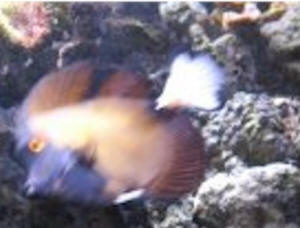
|
Re: mystery tang??? =( Hello!!!
THANK you
very much for the quick response, unfortunately I don't have
any other images ...If you had to take a guess, what would you say?
<Do you know where the fish was collected? Please read here:
http://www.wetwebmedia.com/zebrasom.htm> My
friend who owns this tang would only tell me that its face would go
blue when feeding and/or stressed ( apparently that was a big hint?
lol)...I'm guessing that it might perhaps be some sort of
hybrid? <Not a hybrid... as in a cross between species... likely
a genetic mosaic however... a "Koi" variety... maybe of
Z. flavescens.> Anyway if something comes to mind PLEASE let me
know!!!
Best wishes,
Max |
| Re: My mistake, another photo!!! =) Hello again! ...I
just found another picture that my friend had taken, much
clearer!!!! Any thoughts? Best wishes, Max <Mmm, this pic does
show a much longer "snout"... maybe this is a Z.
rostratum. Bob Fenner> |
|
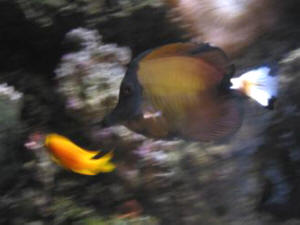
|
Re: My mistake, another photo!!! =) Thank you
very much for all your help, If you have any ideas later on feel free
to let me know!!! I'll keep you updated on the progress of my
search!!! lol <Real good. Thank you. Bob Fenner, still going to get
down to the Mascarenes for that on-sight Gemmatum pic!> Best wishes,
Max
Re: is this a real tang? Click here: Gem Tang
Zebrasoma gemmatum I also saw a tang that looks like it's a yellow
tang but it's all orange. Is that a tang also? Jahner <Yes...
these are not common in Hawai'i (where yellow tangs come from) but
are found occasionally... some all orange, but most mottled with orange
and white. Bob Fenner>
Tang Identification? <Hi, MikeD here> I haven't
been able to find out what exactly one of my favorite fishes name is.
Could you please help me- Click here for photo http://www.xpphotoalbum.com/data/500/11719DSCN0586-med.JPG?1233
It's hard to tell with exact certainty as there are several tang
species that look very similar in the world's tropical seas, but it
looks like Acanthurus bahianus, the Ocean Surgeonfish from the tropical
Atlantic and Caribbean, and if it is, the tail will become lunate as it
grows, edged in blue and it will become even more beautiful. Be advised
as it gets bigger, it can get feisty with newly added fish,
particularly larger ones. Like all tangs, it has hidden
"switchblades" on either side of the tail and it's
favorite song ought to be "Mack the Knife"!> Thank you,
Steve
Look before you leap...please research before (!) you buy!
2/17/04 Hey there, <howdy> I have to tell you, I love this
site. There is an almost unlimited amount of information here and
I've definitely put it to use. <good to hear> I do have one
question though. I bought this tang at the LFS for $14 but
the catch was they didn't know what it was. There invoice had it
listed as assorted tangs. And I've been all over the web looking
for a positive id with no luck, please help. Scott Ballantyne 125 g
reef <Scott... this story may very well have a sad ending. You have
your work cut out for you if nothing else. This is exactly why one
should research an animal before they buy it. Your fish is a Vlamingi
Naso (juvenile) and reaches 2 feet long as an adult. Some people feel
that this fish should not even be imported for private aquarium use.
Even if it only gets half of its adult size in time... your 125 gallon
aquarium is cramped if not cruel in my opinion as housing for it. I see
you state that you've been all over the net looking, but I must
say... where? From our site or most any other archive/database you can
see that your tang's body shape is unique to the Naso genus. Our
archives are filled with advice and occasional pleads with aquarists to
use fishbase.org as a research tool to browse for fish IDs. There you
will find the following info:
http://www.fishbase.org/Summary/SpeciesSummary.cfm?ID=6024&genusname=Naso&speciesname=vlamingii
juv pic:
http://www.fishbase.org/Photos/PicturesSummary.cfm?StartRow=5&ID=6024&what=species
please do be more resourceful and thorough in your searches and above
all... do not buy any animal that you do not know how to feed, house or
even name. My advice is to see if you can find a better home for this
fish (300 gallon plus) in the next year to spare it from stunting or
dieing prematurely. To you/our future success. Anthony>
Tang ID 2/18/04 Thanks again Anthony I really appreciate your
time and information. <and I do appreciate your willingness to learn
and grace while I'm grumpy :) Sincerely> I think you are right,
though the only reason I did write you is because I didn't know
what I had in my tank ( Vlamingi). When I said that I had mostly tangs
I should have listed them, I don't have my tank pack
full of tangs. <ahhh, good. Indeed I did infer that "mostly
tangs" in a 125 gallon tank meant more than a few. You had me
worried :p> The Vlamingi is one, Naso lituratus ( that I wanted to
be my show fish ) then a purple tang. Other fish I have are 2 false
Percs, six line wrasse, and 2 lyre tail Anthias, oh and a rabbit fish.
I've had the purple tang, and rabbit fish since I started my first
tank that's been two years now. The lipstick and Vlamingi I've
had both for a little over a year know but the Vlamingi has tripled in
size since I bought him. <yes... they really are bruisers, and
commonly outgrow even large home aquaria. Some public aquariums refuse
to accept them as donations because it enables out industry to continue
to import/buy these large fishes for inappropriately small tanks> He
had to be only the size of a 50 cent piece when I put him in my tank.
The lipstick tang has widened out but still has only grown 1/2 inch in
length. Is the growth rate of these fish that different? <many would
say so, yes> The Vlamingi , rabbit and lipstick tang all swim
together all day. The purple tang spends most of the day in and out of
the rock work as well as the six line wrasse. Will there be any sings
of stress on the vlamingi or do you think I should trade him now?
<having tripled in size in one year in on par and does not bode well
for his residency. As a subadult, it really cannot stay
in 125 and continue to grow normally/well... especially
shared with another Naso species and other fishes. I'd look for a
bigger house for him bud> I'm not trying to kill the little guy
by waiting till there is a problem but he is gorgeous. I would hate to
see him go. Well once again I have taken to much time. Thanks again.
Scott B <Without the other Naso in the tank, the Vlamingi could stay
a bit longer... a decision to be made. But an easy one IMO - the
Vlamingi is a public aquarium fish. Best of luck, and thanks again for
your interest/desire to be a conscientious aquarist! Kindly,
Anthony>
Mystery Tang? Hello! <Hi there! Scott F. with you!> I
love your website…just stumbled across it recently as I was
trying to identify a tang in my tank. I have a silver-dollar sized
tang; (s)he is putty/beige in color, with blue lips, yellow eyes, and
yellow tail, pectoral and dorsal fins, with a tip of blue along the
fins. When scared (which is almost never, unless I drop the
water-hoover in the tank) (s)he turns a mottled brown and
white. I have looked over 50 different sites
trying to identify…caught off the coast in Okinawa, Japan (East
China Sea side). Any help you can give is greatly appreciated! Thanks!
Faron <Well, Faron- without a photo, I'll just have to take an
educated guess that may at least point you in the right direction.
Based on the description and your geographic locale described, I'd
take a guess and suggest that you look at Acanthurus dussumieri or
Acanthurus nigrofuscus. Again, these are guesses at best. If you send
us a pic, we may be able to nil it for you. Also, do check out
fishbase.org to see some examples of these and other species.
Hopefully, you'll find the information there! Good luck! Regards,
Scott F> Research before you buy please - Tang ID 10/8/03 I
recently purchased a small surgeonfish. As many look
different as juveniles, I came to the thought I have no idea what do I
own..... <ughhh... very disappointing to hear that anyone would take
home a living creature home without knowing what it is, what it eats,
or how big it gets. In this case, you may very well have an open water
planktivorous surgeon (not an herbivore as you probably suspected)...
and quite likely a Naso species that gets 2' long or larger. I
seriously doubt that you have a proper aquarium (500 gall +) to rear
this creature to adulthood> it is definitely Naso shaped, gray, some
weak yellow and blue margins and has small blue spots on it's
"cheeks" and gill area. any suggestions ? <yes... go
to www.fishbase.org ...
type in the genus "Naso" and then scan the pictures of
species in that genus for your victim... er, I mean... guest> my bet
is Naso brevirostris (spotted unicornfish) but I don't know how
does a juvenile look like... thx Asaf <
http://www.fishbase.org/Summary/SpeciesSummary.cfm?ID=6021&genusname=Naso&speciesname=brevirostris Two
feet long and does eat zooplankton as well as algae. Good luck.
Anthony>
|
Blue-eyed Kole Tang? Hi everyone at WWM, <Hello
David> Love the site and recommend it to everyone I see or
talk to for that matter. I have recently purchased a new tang. It
was labeled to the LFS as Blue-eyed Kole tang. I have yet to find
a picture of a juvenile that looks like it. Could you please look
at the picture and tell me your opinion. It has the basic body
structure of a Kole tang, with the same shape to it's jaw
structure and eating habits seem to be similar (he is eating
algae from the wall and rocks not food I am feeding) The colors
are the main thing, He is brownish red with blue highlights
(probably the lighting there ) but has a yellow tail
and yellow lower fins. He does have the sturgeon spine on his
tail and does seem to be timid as most do at first. I placed him
and a Yellow-eyed Kole together in a 55 gallon frag tang to help
control algae. The water parameters is Ph 8.0-8.1, Alk is 10 and
Calcium is 400 ppm, 0 on nitrate, nitrite, and ammonia. All is
good with the health of the animal but I was hoping to see what I
could expect as a long term size and care requirement. I can move
him to a 160 gallon that I already have running a reef if he
grows very large. Thanking you in advance for all the help, You
always are the first place I start and usually end up finding all
my questions and answers. Thanks David <The genus Ctenochaetus
has recently undergone renovation by Dr. John/Jack Randall...
with the addition of species. I think what you have here is a C.
binotatus, but do take a look on fishbase.org under the genus for
your own comparison. Bob Fenner>
|
|
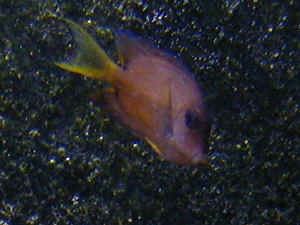
|
- Tang ID - Hi crew I saw a very cool pic of
a tang. I was hoping someone could fill me in on what it is? I
would guess blue/purple tang hybrid but I'm wondering if its a
diff kind. <Pretty sure this is a Acanthurus dussumieri, the
Penciled Surgeon - made distinctive by that white peduncular
spine.> Peace
Sal
<Pax, J -- > |
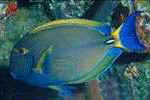 |
Surgeonfishes: Tangs for Marine Aquariums
Diversity, Selection & Care
New eBook on Amazon: Available here
New Print Book on Create Space: Available
here
by Robert (Bob) Fenner |
 |
|
|

